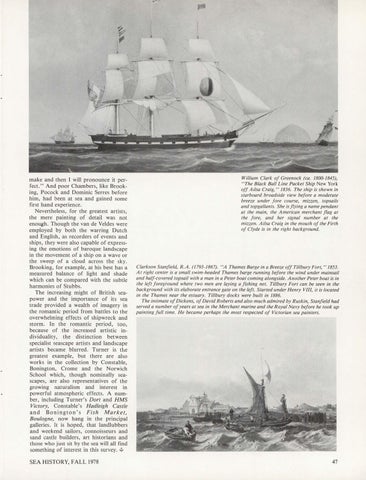..
¡¡~
make and then I will pronounce it perfect." And poor Chambers, like Brooking, Pocock and Dominic Serres before him, had been at sea and gained some first hand experience. Nevertheless, for the greatest artists, the mere painting of detail was not enough. Though the van de Veldes were employed by both the warring Dutch and English, as recorders of events and ships, they were also capable of expressing the emotions of baroque landscape in the movement of a ship on a wave or the sweep of a cloud across the sky. Brooking, for example, at his best has a measured balance of light and shade which can be compared with the subtle harmonies of Stubbs. The increasing might of British seapower and the importance of its sea trade provided a wealth of imagery in the romantic period from battles to the overwhelming effects of shipwreck and storm. In the romantic period, too, because of the increased artistic individuality, the distinction between specialist seascape artists and landscape artists became blurred. Turner is the greatest example, but there are also works in the collection by Constable, Bonington, Crome and the Norwich School which, though nominally seascapes, are also representatives of the growing naturalism and interest in powerful atmospheric effects. A number, including Turner's Dort and HMS Victory, Constable's Hadleigh Castle and Bonington's Fish Market, Boulogne, now hang in the principal galleries. It is hoped, that landlubbers and weekend sailors, connoisseurs and sand castle builders, art historians and those who just sit by the sea will all find something of interest in this survey . .t SEA HISTORY, FALL 1978
William Clark of Greenock (ca. 1800-1845), "The Black Ball Line Packet Ship New York 'off Ailsa Craig," 1836. The ship is shown in starboard broadside view before a moderate breeze under fore course, mizzen, topsails and topgallants. She is flying a name pendant at the main, the American merchant f lag at the fore, and her signal number. at the mizzen. Ailsa Craig in the mouth of the Firth of Clyde is in the right background.
Clarkson Stanfield, R.A. (1793-1867). "A Thames Barge in a Breeze off Till bury Fort," 1853. At right center is a small swim-headed Thames barge running before the wind under mainsail and half-covered topsail with a man in a Peter boat coming alongside. Another Peter boat is in the left foreground where two men are laying a fishing net. Tillbury Fort can be seen in the background with its elaborate entrance gate on the left. Started under Henry Vlll, it is located in the Thames near the estuary. Tillbury docks were built in 1886. The intimate of Dickens, of David Roberts and also much admired by Ruskin, Stanfield had served a number of years at sea in the Merchant marine and the Royal Navy before he took up painting full time. He became perhaps the mos/ respected of Victorian sea painters.
47
